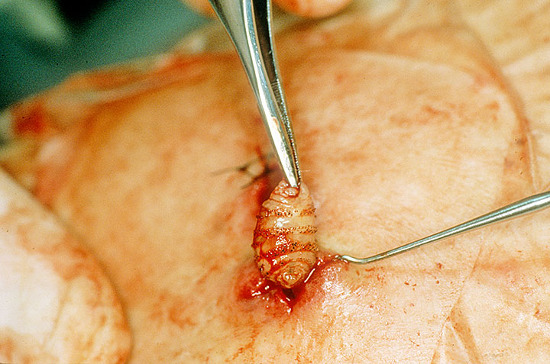Detecting carnivorous maggots living under human skin
The nightmare for all travelers has come true for an Australian couple while on vacation in South America: The carnivorous maggots began to nest under their skin.
The New Zealand Herald newspaper reported that Bryan Williams and Ally Vaag are traveling around the Amazon basin when mosquitoes are bitten. However, by the time they arrived in Bolivia, mosquito bites on their skin began to develop oozing pustules, requiring medical intervention to remove maggots living inside the wound.

The larvae of the buffalo fly penetrate into the skin of the parasite
through insect stings. (Photo: Health News)
These pests are identified as larvae of the Dermatobia hominis , a predominantly central and southern American flyfly , according to the Institute of Agricultural and Food Science at the University of Florida (USA). Despite the ability to exacerbate wounds, these creatures are easily destroyed or eliminated.
Dermatobia hominis is quite unusual. Females cling to a blood-sucking insect, usually a mosquito or aphids, and lay eggs on the body of the intermediate animal before leaving. When mosquitoes or bugs bite humans or mammals, other hot blood, buffalo eggs will react to temperature changes and hatch into tiny (maggot) larvae, penetrating the host's skin through wound by insect bite.
Although maggots eat pus inside the skin, they still need to breathe through small pores on the skin's surface. They make the nest under the skin swell, producing pus and painful fluid.
After about 8 weeks, the adult larvae will leave the wound to the ground, where they grow into winged buffalo flies.
Until now, people have not discovered buffalo flies that spread any form of infection. In fact, it is easy to remove harmful organisms in many ways, such as just applying moisturizer that covers the wound to suffocate the maggots, then use tweezers to remove them.
Dr. Marc Shaw of New Zealand's Center for International Immunization and Health Services said the best way to prevent buffalo infection is to avoid mosquito bites: always wear long-sleeved shirts and pants; Use insecticides to keep the flies away.
- Meat-eating maggots turn dozens of deer into living corpses
- Scary flies can cause diseases for humans
- Horror discovered maggots in favor of girls
- America: Detecting meat-eating maggots nesting in the legs because of insect bites
- The dangerous 'carnivorous' parasite has returned and is more beneficial than before
- Human skin can 'sniff' the smell
- 10 interesting things about human skin
- Discovered where mushrooms have the greatest diversity in human skin
- Detecting maggots coming out of the leg after the tour
- 'Planting' ... human skin in the laboratory
- Detecting new carnivorous plants
- Human skin can change color continuously in the future
 Why do potatoes have eyes?
Why do potatoes have eyes? 'Tragedy' the world's largest carnivorous life: Death becomes ... public toilet
'Tragedy' the world's largest carnivorous life: Death becomes ... public toilet Tomatoes were once considered 'poisonous' for 200 years
Tomatoes were once considered 'poisonous' for 200 years Detecting microscopic parasites on human face
Detecting microscopic parasites on human face